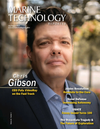
Page 33: of Marine Technology Magazine (July 2023)
Read this page in Pdf, Flash or Html5 edition of July 2023 Marine Technology Magazine
Clearing the beach with the Bayo- net 250. Photo Bayonet
The autonomous underwater vehicle (AUV) Cuttle? sh, developed at DFKI, serves as the robotic test platform. The
AUV has two deep-sea capable gripping systems for ? exible handling of objects underwater. Thanks to its design and AI- based control, it can change its center of gravity and buoyancy during a dive and like images based on low-resolution learned hydrodynamic model, the AUV assume any orientation. Comprehensive sonar data. That way, a comprehensive can precisely readjust its pose automati- environment perception thanks to sensor reconstruction of the target object in 3D cally at runtime. To avoid arm collisions, fusion and generative AI In the case of is possible. To enable precise arm move- the researchers are also developing soft- recovering munitions from oceans, the ments, the entire vehicle, including the ware that coordinates arm movements
AUV must be able to approach its target arms, must be included in the control. in real time. Tactile force sensors on the object without colliding with it. For this Therefore, the scientists are resorting to robotic grippers allow sensitive and, in purpose, the vehicle is equipped with a modern approaches of whole-body con- case of doubt, compliant handling of am- variety of sensors such as sonars, cam- trol, which they combine with learned munition residues. The aim of the ma- eras, laser scanners and magnetometers. behavior. A deep neural network-based nipulation is to attach lifting gear to the
However, due to the highly variable algorithm learns how the vehicle behaves casings of old ordnance in order to lift environmental conditions underwater, under different conditions. Thanks to the and transport it. the robot can only partially sense its sur- roundings at a low resolution, impeding
Seamor UXO Detection System navigation and object detection. So the scientists combine acoustic and opti- Seamor Marine’s Chinook ROV is making waves in the ? eld of UXO detec- cal sensor data using probability-based tion after a successful compact magnetometer integration with subsea engineers sensor fusion. Thus, the quality of the at Ocean Floor Geophysics. ROVs hold promise to subsea engineers designing high-resolution camera data especially magnetometer scanning systems, however, technicians have been challenged depends on the prevailing light and by the electro-magnetic interference created by the electrical systems of these visibility conditions. Acoustic sensors, smaller units. Earlier this year, Seamor Marine was contracted at the request however, are independent of visibility of a private client through Ocean Floor Geophysics for a third-party integration conditions, but only provide data with of their magnetometer with the Chinook ROV. “Seamor’s Chinook is compact, signi? cantly lower resolution. In addi- maneuverable, and reliable,” said Nathan Ehrenholz, subsea robotics engineer at tion to that, their functionality is limited Ocean Floor Geophysics. Most ROV pilots make use of the built-in, movable at close range. To close the gaps in ob- camera during inspections and scans, but that was not an option for this trial. ject detection, the researchers are also The solution was to ? x the camera in place, using the Chinook’s quiet thrusters relying on the use of generative AI al- to reposition the magnetometer while mapping rather than the pan/tilt feature of gorithms. This involves training a neural the built-in camera.
network so that it can generate camera-
Your Sensors. Our Software.
Survey The World With HYPACK!
HYPACK gives you a clear view above and beneath the surface. We provide software for all of your hydrographic and dredging needs.
HYPACK® | HYSWEEP® | DREDGEPACK® [email protected] www.marinetechnologynews.com 33
MTR #5 (18-33).indd 33 7/21/2023 9:14:54 AM

 32
32

 34
34
